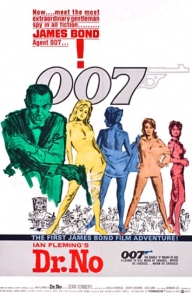Geographies of Bond
With the 50th Anniversary of the release of Dr No (Connery, 1962) and the launch of Skyfall (Craig 2012) late last year, renewed attention was paid to the James Bond series of movies. Amongst this interest there were several noteworthy geographic contributions, including articles in The Atlantic Cities, which incorporated a (Google) map of the Geography of James Bond, a photo collection from Discovery News, incorporating a piece by Prof. Klaus Dodds. Building on these, I wish to add my own thoughts on the geographies of Bond.
A feature of the films is the protagonist’s “hyper-mobility”, as Dodds labels it, with the “footloose spy” hopping from place-to-place, sometimes traversing the globe in the two-hour adventure. This demonstrates the exciting lifestyle of the fictionalised espionage world, brings the film to new and exotic locations, shows the high-level stakes involved and helps keep the plot moving along nicely. In The Living Daylights (Dalton, 1987), for example, his movements take him to Czechoslovakia, Austria, Britain, Tangier and Afghanistan. Furthermore, his mobility also sees him going underwater, to the extremes of the planet and even into space. In this regard, Bond’s characteristics – privilege, charisma, occupation, funding, determination, and disregard for rules and authority – combine to make him the ultra-mobile modern man.
The far-off and exotic settings mainly show a simplified and stereotype-filled view of the world. This is obviously not unusual in cinematic terms, however it was a central element of the Bond Franchise. In the blog, Geographic Travels, it is pointed out that the top most visited cities, besides London (which features in every film except You Only Live Twice (Connery 1967) and Moonraker (Moore 1971)) are Istanbul, Hong Kong and Venice, which evoke ideas of Near East Oriental exoticism, Far East Oriental exoticism and Picturesque Europe, respectively. Furthermore, Bond took us to these marvellous places, which in turn imbued him with their enticing nature. From his first outing to Jamaica to his most recent in Hong Kong, the man and the place define each other.
However, there is, as always, slightly more to the story. You Only Live Twice (Connery 1967) was based in Japan, and while it may not have offered a holistic or realistic view of the society and culture, it was one of the first times that Japan had featured so heavily in a major Western film since WWII. Just over two decades after that conflict, there would still have been sensitivities and political concerns surrounding Japan, especially in the US. In this regard the exotic location, although simplified, may have provided a service. On a side note, I also came across the idea that the Japanese Secret Service ninjas which stormed Blofeld’s secret volcano lair (the prototypical Bond set-up, satirised in the Austin Powers films) was one of the earliest sightings of ninjas in Western pop-culture.
Another factor in Bond’s mobility is the role of vehicles. The cars obviously stand out as the main type of transport associated with 007. However, his missions have included boats, naval vessels, planes, helicopters, submarines, trains, cable cars, ski mobiles, a double-decker bus, a blimp, a moon buggy, an autogyro (Little Nellie) a space shuttle, and an ‘alligator’ boat. While many of the vehicular scenes are about chase and explosions, there is also an implicit prioritisation of the mobile (see my post on Mobilities). Movements, spaces of mobility and mobile locations, which are frequently overlooked in cinema and television matter in the Bond-verse. So, for example, M’s office, complete with Moneypenny, can be on a submarine; the fate of the world can be controlled from an oil-tanker; and, a missing helicopter is central to the plot.
The collective content of the twenty-three films have so much material jammed into them that it is the stuff of dreams for academics and socio-cultural commentators. There are numerous other topics that could be covered in any geographical discussion of Bond, including gender roles, geo-politics (and the concept of the licence to kill), the theme songs, technology and fashion. But as we know James Bond will return soon, maybe another post might also appear…

